On Monday I visited the Zoology Department at Dakar University, where they have specimens of most of Senegal’s species, including a partial manatee skeleton on display (no flippers). The curator wasn’t there, so I’ll contact him later for information about where it came from and how long ago it was acquired, but from the size of the skeleton, it appears to be a juvenile. Unfortunately it was falling apart a bit, but I give them credit for effort, because it takes alot of work to display a manatee skeletons in a lifelike way (3-D rather than flat on a table!). I’d like to get permission to take a sample for genetics analysis, as well as a sample of the earbone for age determination (still inside the skull, which is rare in a display specimen, they usually fall out).
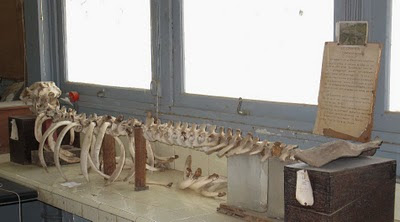 The skeleton also included part of a mummified manatee tail (I’m not sure what’s up with the mummified manatee parts in Senegal!).
The skeleton also included part of a mummified manatee tail (I’m not sure what’s up with the mummified manatee parts in Senegal!).
 Also with the skeleton is a brief general description about West African manatees, as well as this old postcard from the Royal Belgian Museum of Natural History. The manatee drawing is pretty good, although I got a chuckle out of the two baby manatees nestled on the beach at the right side of the drawing! Clearly the artist wasn’t aware manatees are completely aquatic.
Also with the skeleton is a brief general description about West African manatees, as well as this old postcard from the Royal Belgian Museum of Natural History. The manatee drawing is pretty good, although I got a chuckle out of the two baby manatees nestled on the beach at the right side of the drawing! Clearly the artist wasn’t aware manatees are completely aquatic.
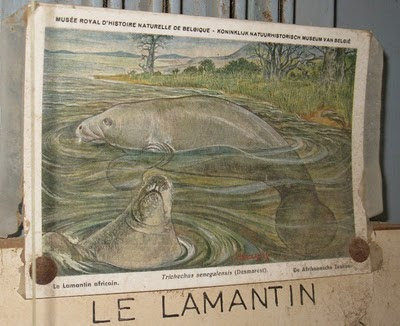 Also this week, a colleague at the Senegal River Development Authority forwarded the following photos of a manatee mating herd taken in the Senegal River near the town of Dagana in July 2008. Photos of manatees in Africa are rare enough, but to capture a mating herd is truly lucky! All the following photos are courtesy of Mr. Van Kutten of SAED.
Also this week, a colleague at the Senegal River Development Authority forwarded the following photos of a manatee mating herd taken in the Senegal River near the town of Dagana in July 2008. Photos of manatees in Africa are rare enough, but to capture a mating herd is truly lucky! All the following photos are courtesy of Mr. Van Kutten of SAED.
For those of you not familiar with manatee mating behavior, usually a group of males (groups of up to 10 have been witnessed in FL) pursues a female, all attempting to mate with her. Not surprisingly, the female often tries to escape her suitors, who climb all over her and chase her until they are successful. All of this activity is usually very visible to any nearby human observer, because the manatees roll in the water with backs and tails flying. In Africa unfortunately this can also put manatees at risk for hunting; I know of at least one case where hunters went out and killed manatees in a mating herd, taking advantage of the manatees temporary ambivalence towards humans.
A male manatee climbing on top of a female (who is not visible in the muddy water)
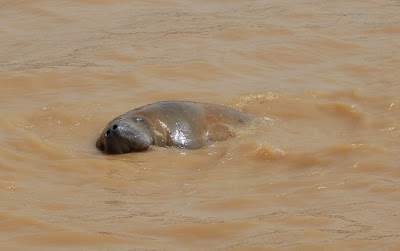 Another shot of an amorous male… you can see a tiny piece of the female’s back under his flipper
Another shot of an amorous male… you can see a tiny piece of the female’s back under his flipper
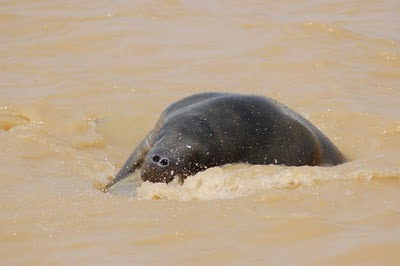 Several males and alittle bit of the back of the female is visible.
Several males and alittle bit of the back of the female is visible.
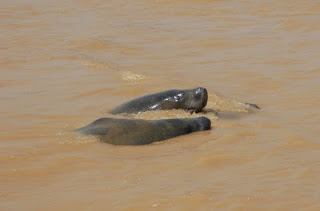 Noses in the river. Often the female tries to swim away from the males, so photos such as this (of the male in pursuit) are common for mating herds.
Noses in the river. Often the female tries to swim away from the males, so photos such as this (of the male in pursuit) are common for mating herds.
 The skeleton also included part of a mummified manatee tail (I’m not sure what’s up with the mummified manatee parts in Senegal!).
The skeleton also included part of a mummified manatee tail (I’m not sure what’s up with the mummified manatee parts in Senegal!). Also with the skeleton is a brief general description about West African manatees, as well as this old postcard from the Royal Belgian Museum of Natural History. The manatee drawing is pretty good, although I got a chuckle out of the two baby manatees nestled on the beach at the right side of the drawing! Clearly the artist wasn’t aware manatees are completely aquatic.
Also with the skeleton is a brief general description about West African manatees, as well as this old postcard from the Royal Belgian Museum of Natural History. The manatee drawing is pretty good, although I got a chuckle out of the two baby manatees nestled on the beach at the right side of the drawing! Clearly the artist wasn’t aware manatees are completely aquatic. Also this week, a colleague at the Senegal River Development Authority forwarded the following photos of a manatee mating herd taken in the Senegal River near the town of Dagana in July 2008. Photos of manatees in Africa are rare enough, but to capture a mating herd is truly lucky! All the following photos are courtesy of Mr. Van Kutten of SAED.
Also this week, a colleague at the Senegal River Development Authority forwarded the following photos of a manatee mating herd taken in the Senegal River near the town of Dagana in July 2008. Photos of manatees in Africa are rare enough, but to capture a mating herd is truly lucky! All the following photos are courtesy of Mr. Van Kutten of SAED. Another shot of an amorous male… you can see a tiny piece of the female’s back under his flipper
Another shot of an amorous male… you can see a tiny piece of the female’s back under his flipper Several males and alittle bit of the back of the female is visible.
Several males and alittle bit of the back of the female is visible. Noses in the river. Often the female tries to swim away from the males, so photos such as this (of the male in pursuit) are common for mating herds.
Noses in the river. Often the female tries to swim away from the males, so photos such as this (of the male in pursuit) are common for mating herds.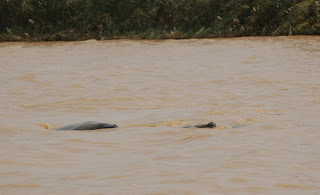

These are some cool pics i have never heard of this beautiful sea animal.
sierrasdogtalk.blogspot.com
I don't know alot about these animals but these pics are greatn